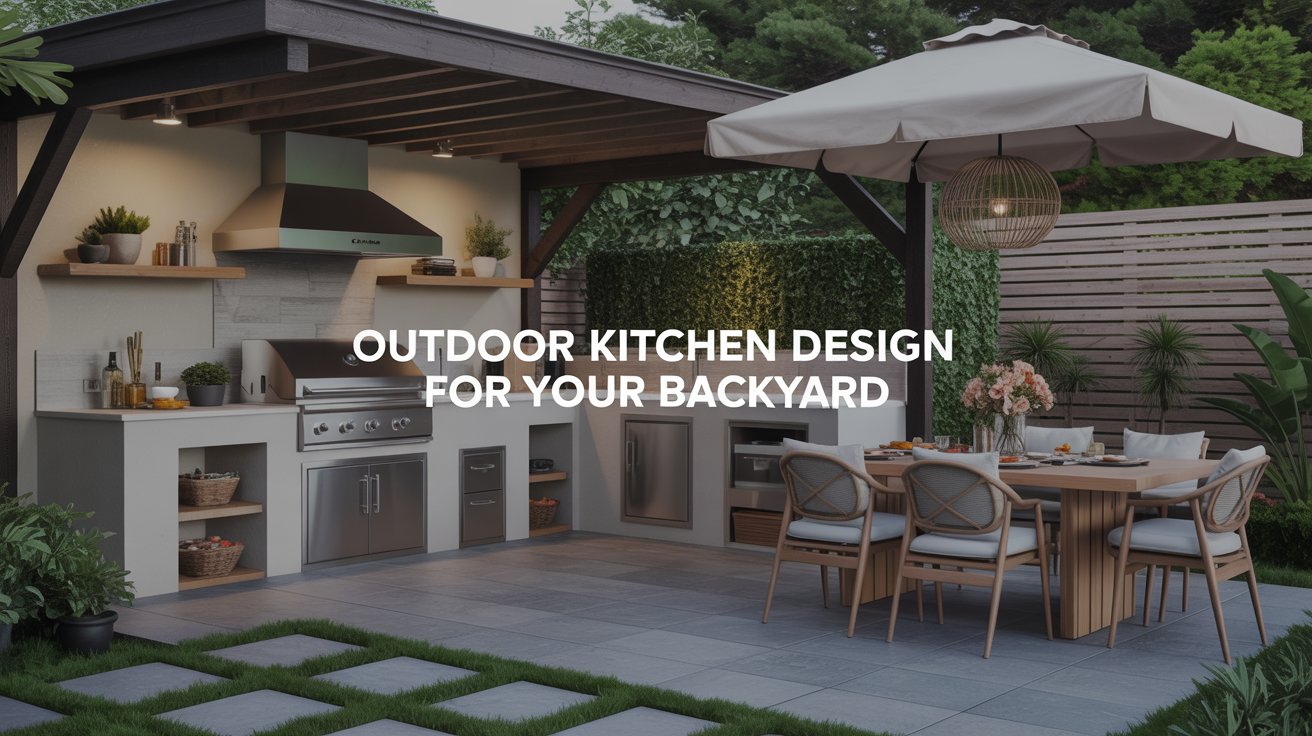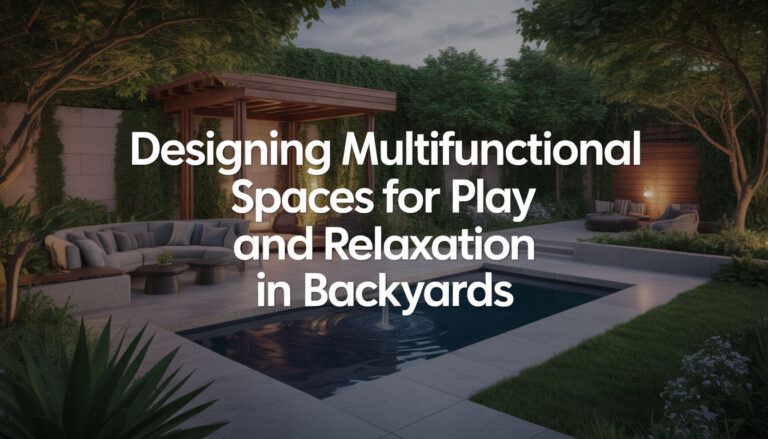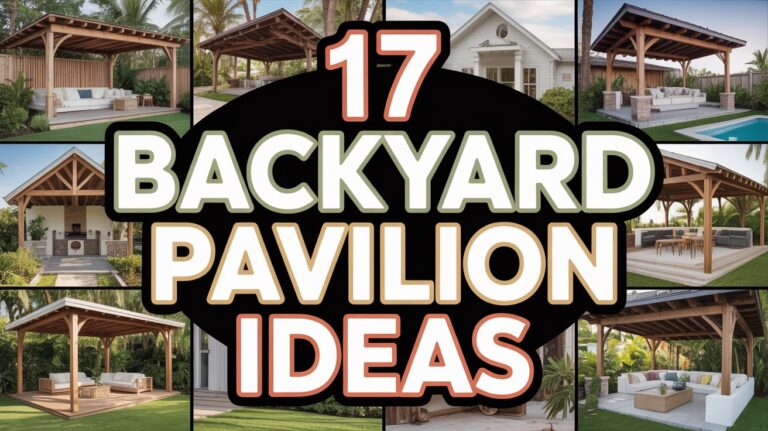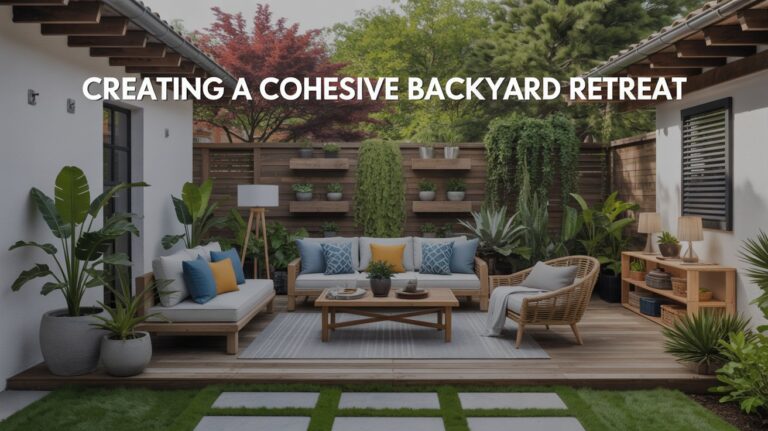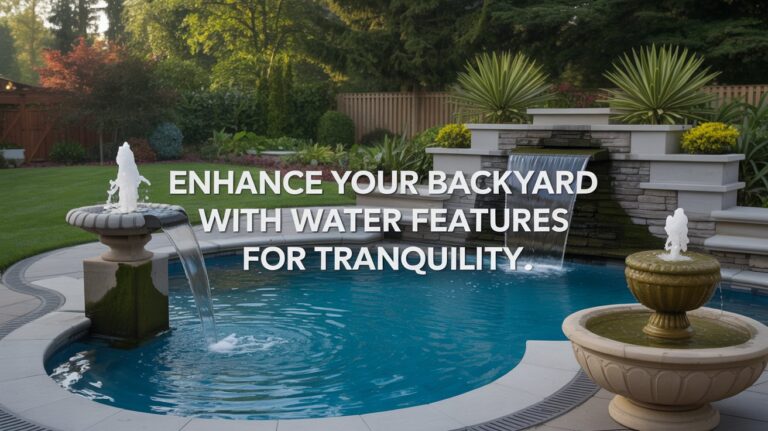How to Design a Functional Outdoor Kitchen for Your Backyard
I have been, or can be if you click on a link and make a purchase, compensated via a cash payment, gift, or something else of value for writing this post. As an Amazon Associate, I earn from qualifying purchases. Please read my full Affiliate Disclosure for more information.
To design a functional outdoor kitchen, center the work triangle among grill, sink, and refrigeration, keeping all key surfaces on a single plane for minimal reach and backtracking. Choose durable, weather-ready materials with fire-resistant substrates and sealed, weatherproof enclosures. Zone prep, cooking, eating, and cleanup thoughtfully, with sheltered, climate-adaptable shading and lighting. Guarantee weatherproof power, labeled storage, and easy maintenance. When you keep these principles in balance, you’re set for year‑round use and efficient workflows—and there’s more to optimize ahead.
Key Takeaways
- Center the work triangle by placing grill, sink, and refrigeration on a single plane to minimize movement.
- Plan durable, weatherproof finishes and sealed enclosures with rust-proof hardware for long outdoor use.
- Locate prep near storage and water access, and cooking zones near ventilation for efficient workflow.
- Use layered lighting (task, ambient, accent) with weather-sealed fixtures and integrated controls for safety year-round.
- Incorporate drainage, frost-proof water supply with accessible shutoffs, and zoning to manage weather and maintenance.
Choosing a Layout That Keeps the Work Triangle Efficient
A well-placed layout centers the work triangle among the grill, sink, and refrigeration, minimizing travel distance and facilitating fluid movement between core tasks. You’ll optimize paths by aligning these zones along a single plane, reducing corners and backtracking. Consider counter depth alignment, ensuring accessible surfaces within arm’s reach for food prep, cooking, and cleanup. Maintain clear circulation around the triangle to accommodate entertaining arrangements without crowding. Landscape integration guides exterior sightlines and shade, while durable materials resist weather exposure. This layout supports efficient task sequencing, ergonomic reach, and adaptable zones that scale with evolving outdoor entertaining requirements.
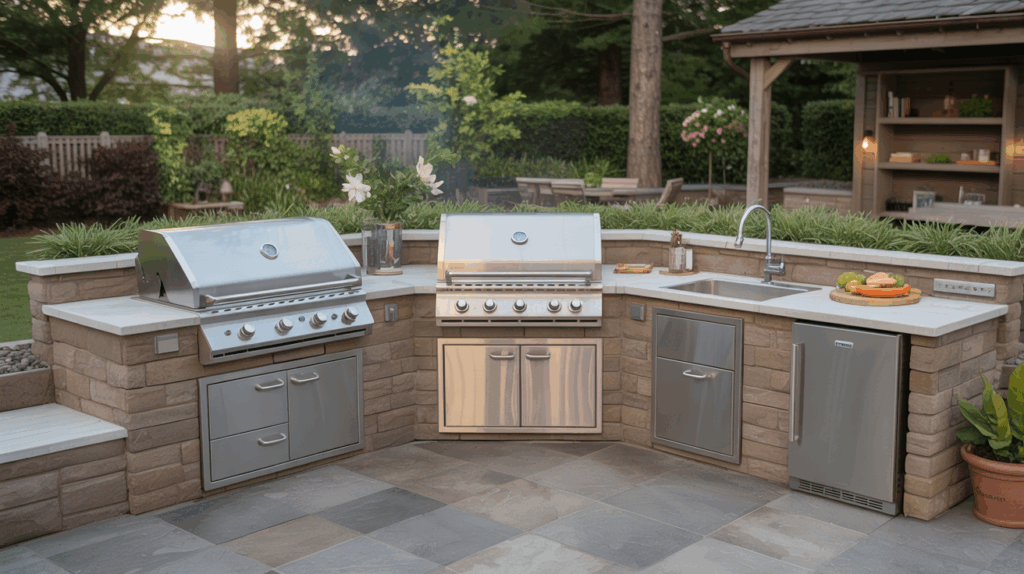
Selecting Durable, Weather-Ready Appliances and Materials
When selecting durable, weather-ready appliances and materials, prioritize corrosion resistance, low-maintenance finishes, and proven outdoor performance ratings, ensuring components stand up to sun, rain, and temperature swings. You’ll evaluate fire resistant surfaces for countertops and cabinetry, favoring non-porous, heat-dissipating substrates. Choose rust proof hardware with coated fasteners and stainless steel where joints endure repeated exposure. Outfit appliances with sealed controls, weatherproof electrical enclosures, and efficient ventilation. Verify UV stability, easy-to-clean surfaces, and stable colorfastness. Design details should balance aesthetics and durability while minimizing maintenance, enabling consistent performance across seasons without compromising safety or function.
Creating Thoughtful Zones for Prep, Cooking, Eating, and Cleanup
To create a functional outdoor kitchen, organize distinct zones for prep, cooking, eating, and cleanup that align with workflow and safety protocols. You should map adjacencies so tools, surfaces, and waste flow efficiently from one zone to the next, reducing trips and cross-contamination risks. Position the prep area near storage and water access, the cooking zone with ventilation, and the dining zone at a comfortable distance for social interaction. Ensure line-of-sight between zones for supervision and maintenance. Consider outdoor decor and landscape integration to blend spaces, while preserving durable materials and accessible maintenance paths for long-term use.
Designing Smart Storage and Weatherproof Power Solutions
Smart storage layouts should be planned around accessibility and workflow, with labeled zones for dry goods, cookware, and cleanup to minimize motion. Weatherproof power options must align with appliance schedules, with GFCI protection, outdoor-rated outlets, and cord management that maintain clean sightlines. Use durable cabinet materials that resist moisture and UV exposure, ensuring weather resistance while supporting a tidy, low-maintenance outdoor kitchen.
Smart Storage Layouts
Designing efficient storage in an outdoor kitchen hinges on modular layouts that keep frequently used items at arm’s reach, while weatherproofing power sources protects both longevity and usability. You’ll implement tall, shallow pullouts and labeled bins to minimize reach, while integrated gaps accommodate changing toolkits. Group zones by task: prep, cooking, serving, cleanup, with clear sightlines from work surfaces. Use durable, water-resistant finishes and magnetic closures to reduce noise and snagging. Prioritize innovative storage solutions that balance accessibility and integrity, enabling space optimization without crowding. Precision hardware, consistent tolerances, and predictable pull ranges ensure repeatable, ergonomic operations.
Weatherproof Power Options
Weatherproof power options require deliberate enclosure, rugged wiring, and moisture-rated components that endure outdoor conditions without compromising performance. You’ll design a dedicated, GFCI-protected circuit strategy, integrating weather-sealed receptacles and a centralized power hub positioned behind a protective panel. Use conduit routing that minimizes exposure, with drip loops and cable management that prevents snagging. Select outdoor-rated, tamper-resistant outlets and low-profile switches, sized for peak load during cooking and entertainment events. Incorporate integrated sound and outdoor entertainment accessories through a weatherproof interface, ensuring EMI control and safe separation from water sources. Document ingress protection codes for every component and test under real conditions.
Durable Cabinet Materials
Durable cabinet materials must withstand outdoor exposure while integrating storage with weatherproof power solutions, so choose substrates and finishes that resist moisture, UV, temperature cycling, and impact. You’ll optimize methods with sealed edge profiles, marine-grade plywood, and aluminum or high-pressure laminates, ensuring long-term rigidity and minimal warping. Pair with hardware finishes that resist corrosion, while preserving a refined aesthetic. Aim for elegant finishes and decorative accents that harmonize with surrounding elements without compromising performance. Prioritize test data on weathering and load, and plan for drainage and ventilation to prevent moisture buildup.
- Substrate selection and sealing approach
- Corrosion-resistant hardware options
- Thermal expansion considerations
- Finishes that balance durability with elegance
- Decorative accents integration
Incorporating Lighting, Shade, and Shelter for Year-Round Use
To support year-round use, you’ll specify lighting that maintains consistent visibility across seasons and tasks, with controls for brightness, color temperature, and energy efficiency. Consider shading strategies and comfort integrations that adapt to sun angle and wind while preserving access to the cooking area. The shelter design should balance protection and openness, ensuring ventilation and rain protection without compromising workflow.
Lighting for All-Season Use
How can you guarantee lighting supports year‑round use without compromising comfort or safety? You design for spectrum, placement, and control, prioritizing durable fixtures, weather seals, and glare reduction. Integrate lighting with landscape elements to enhance landscape integration, while considering outdoor acoustics for perceived ambience during gatherings. Use layered lighting—task, ambient, and accent—paired with smart controls and weather-ready components to maintain function in cold, heat, and humidity. Ascertain electrical safety with outdoor-rated conduits and GFCI protection, and budget for seasonal maintenance.
- Fixture zoning by function and zone
- Weatherproof, frost‑trost‑rated luminaires
- Dimmable LEDs with color tuning
- Passive and active shade interplay
- Smart, weather‑responsive scheduling
Shading Strategies and Comfort
Shade and shelter are essential to year‑round comfort, guiding the integration of lighting, plantings, and structure to control sun exposure, glare, and wind while preserving view and accessibility. You design shading with measurable impact: horizontal canopies and vertical screens reduce glare by defined percentages; operable louvers adjust solar gain; permeable shade fabrics balance ventilation and light diffusion. Align shade solutions with driveway and kitchen workflow, ensuring access to cooking zones remains unobstructed. Plan for patio comfort through thermal buffering, material choice, and durable finishes. Integrate lighting junctions with shaded zones, avoiding glare and creating consistent, usable ambience after sundown.
Shelter Design for Year-Round Function
Shelter design for year‑round use integrates lighting, shade, and enclosure to maintain comfort across seasons while preserving access to the cooking and dining zones. You’ll specify enclosure depth, venting, and material fire resistance to guarantee safe operation during wind and rainfall while minimizing heat gain. Focus on predictable environmental performance, with durable detailing and easy maintenance. You’ll align shelter elements to the kitchen layout, supporting fluid transitions between indoor and outdoor zones. Landscape integration guides sightlines, drainage, and microclimates. Include lighting redundancy and modular shading for adaptability across climates.
- Fire resistant materials specification and testing
- Shade system performance under varying sun angles
- Weatherproof enclosure detailing and seals
- Integrated lighting zoning and control strategy
- Landscape integration for drainage, sightlines, and windbreaks
Finishing Touches: Sink, Water, and Outdoor-Grade Details
To finish a durable outdoor kitchen, the sink, water supply, and outdoor-grade details must be designed for reliability and ease of use in all conditions. You’ll select a sink installation that accommodates outdoor exposure, with corrosion-resistant hardware, slip-resistant bowls, and proper drainage. Align the plumbing with frost protection and accessible shutoffs, ensuring simple maintenance. Integrate water features that control flow, pressure, and filtration without clutter. Detail counter clearance, splash containment, and appliance gaps to minimize cleanup. Choose weatherproof materials and sealed connections. Test for leak integrity, drainage efficiency, and environmental resilience to sustain performance across seasons.
Conclusion
You’ve designed a functional outdoor kitchen that balances efficiency and durability. Prioritizing a compact work triangle, weather-ready appliances, and clearly defined zones keeps prep, cook, and cleanup streamlined. Smart storage and weatherproof power minimize clutter and downtime. Add strategic lighting, shade, and shelter to extend usability year-round. Finish with a reliable sink and outdoor-grade materials for maintenance ease. This technically focused approach delivers a resilient, low-maintenance space that performs well in diverse conditions and enhances backyard value.
